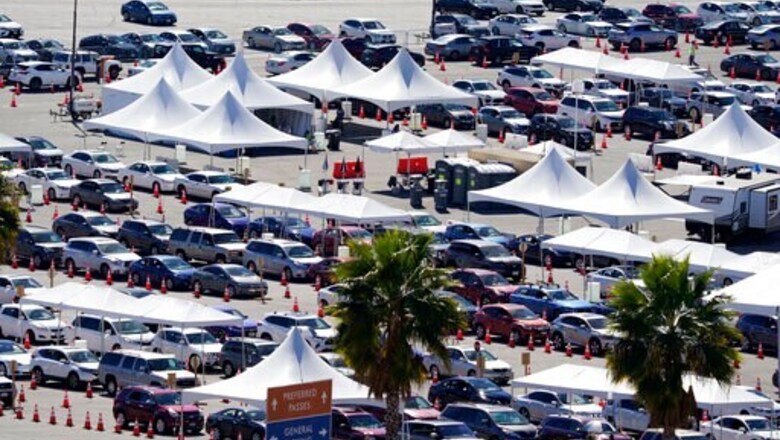
views
President Joe Biden’s promise that all of the nation’s 255 million adults will be eligible for coronavirus vaccines by May 1 means the U.S. needs to move fast.
Within the next seven weeks, the federal government must deliver doses to hundreds of new vaccination sites and recruit a new wave of health care workers to administer the shots.
Simply distributing the vaccines will not be enough, though. The government also aims to simplify the often-frustrating sign-up process and bring shots to communities that are having the hardest time getting vaccinated.
Here’s how public health officials intend to meet the president’s deadline and the challenges that lie ahead.
___
WHAT WILL HAPPEN MAY 1?
That’s the date that Biden wants states to make all adults eligible for the vaccines, but it does not mean everyone will be able to get a shot immediately or even soon after. White House officials expect enough doses to be available for everyone by the end May. How quickly the shots are given will depend on establishing hundreds of new vaccination sites and other distribution points. Some states will move at a faster pace. Michigan’s governor said Friday that all adults will be eligible for vaccines beginning in early April. Alaska this week became the first state to open up to anyone 16 or older.
___
IS THE GOAL REALISTIC?
The May 1 goal is reasonable, and the administration may be using it to urge states and communities to prepare to administer a lot more vaccine, said Dr. Joshua Sharfstein, a former FDA deputy commissioner and a Johns Hopkins professor.
The problem is, if youre just waiting to see how much vaccine you have before you schedule the clinic, then youre building in a lot of delays, he said.
To say, Look, were going to be able to vaccinate everyone, every adult who wants it, thats sending a signal to everyone: Get ready.
___
HOW WILL OFFICIALS HANDLE THE BIG INCREASE?
The Biden administration is counting on expanding the number of large drive-thru vaccination sites and neighborhood centers. It plans to double the number of federally run mass-vaccination locations and double the number of retail pharmacies enrolled in the federal distribution program to more than 20,000. It also will add more mobile clinics and send doses to community health centers to reach under-served and hard-hit communities.
___
WHO WILL GIVE THE SHOTS?
Getting millions of doses into the arms of adults will not be possible without a big increase in the number of health care workers and volunteers. Biden’s plan calls for allowing veterinarians, dentists, optometrists, midwives, physician assistants, medical students and others to administer the shots. The president also says 4,000 more active-duty troops will be brought in to help with the vaccination efforts. That’s in addition to 2,000 who already are assisting.
___
HOW WILL THEY REACH EVERYONE?
People in hard-hit communities and low-income neighborhoods have been falling through the cracks because of language barriers, lack of transportation and lack of access to online registration, among other obstacles. Mistrust of the vaccine also plays a role. The Biden administrations plan is to put more doses closer to where people live through mobile clinics and by sending vaccines directly to another 700 community health centers, bringing the total to 950. We’re ensuring that equity remains at the center of our response, said Dr. Marcella Nunez-Smith, chair of the White Houses COVID-19 equity task force.
WHAT DO PUBLIC HEALTH EXPERTS SAY?
Dr. Ashish Jha, dean of the Brown University School of Public Health, said guidance from the White House, conversations with manufacturers and a review of other data indicates that there will be a huge increase” in the number of vaccines available to the American people over the next month.
Right now, theres still not enough supply, he said. But by late April and early May, the supply will exceed demand.
Certainly by May, if not earlier, were going to have plenty of vaccine for anybody who wants it, he said.
Jha said the country currently has the capacity to give 2.5 million to 3 million shots per day, and now states need to be working to make sure they have distribution capacity and can vaccinate at a national rate of 4 million to 5 million a day.
___
WHAT ABOUT THE SIGN-UP FRUSTRATIONS?
Securing a slot to get the vaccine has been maddening for many. And that’s with only a sliver of the population eligible. A new poll from The Associated Press-NORC Center for Public Affairs Research shows that about 4 in 10 Americans think the process has been poor. Biden says his administration will have a nationwide website up and running by May 1 to show people where the vaccine is can be found. There will be a phone center available by that time too to assist with tracking down doses. The federal government will also work with local agencies to improve their sign-up sites. The president says the goal is no more searching day and night for an appointment.
___
WHERE DOES THE VACCINATION EFFORT STAND RIGHT NOW?
More than 100 million Americans have already received at least one shot, and nearly 66 million are fully vaccinated. Many more will have received shots by May 1, somewhat alleviating the bottleneck that expanded eligibility is likely to create.
___
WHATS THE ENDGAME?
Biden is targeting the Fourth of July as the date when the nation could mark significant progress. But he tempered his optimism by warning that getting there will rely on people following public health guidelines and getting vaccinated soon after they are eligible.
___
Associated Press Writer Michelle R. Smith in Providence, Rhode Island, contributed to this report.
Disclaimer: This post has been auto-published from an agency feed without any modifications to the text and has not been reviewed by an editor
Read all the Latest News, Breaking News and Coronavirus News here



















Comments
0 comment